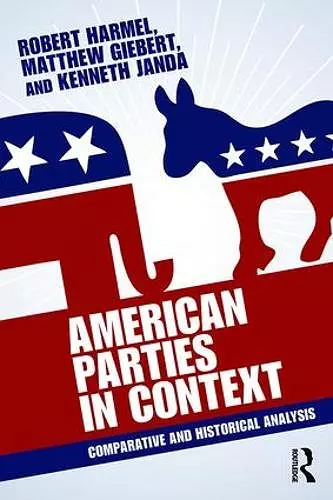American Parties in Context
Comparative and Historical Analysis
Kenneth Janda author Robert Harmel author Matthew Giebert author
Format:Paperback
Publisher:Taylor & Francis Ltd
Published:13th Apr '16
Currently unavailable, and unfortunately no date known when it will be back
This paperback is available in another edition too:
- Hardback£145.00(9780415843676)

Roughly sixty-five years ago, a group of political scientists operating as the "Committee on Political Parties" of the American Political Association thought long and hard about whether the American parties were adequately serving their democracy, and made specific recommendations for improvements. Comparing the parties of this country to those of Great Britain, the Committee found the American parties to be lacking in such fundamentals as clear policy differences, strong and effective organization, and unity of purpose among each party’s representatives in public offices.
Starting from that background, this book is intended to significantly enhance students‘ understanding of the American parties today by putting them in broader context. How do the twenty-first century Democrats and Republicans compare to the APSA Committee’s "responsible parties model" of the mid-twentieth? And how do the American parties compare to parties of other democracies around the world, including especially the British parties?
Harmel, Giebert, and Janda answer those questions and, in the process, demonstrate that the American parties have moved significantly in the direction of the responsible parties model, but while showing little inclination for implementing the greater discipline the Committee thought essential. Already having provided as much ideological choice as the British parties, the US parties have now edged closer on the other critical requirement of legislative cohesion. The authors show that the latter has resulted "naturally" from the greater homogenization of the meaning of "Democrat" and "Republican" across the country, both within the electorate and now within Congress as well. The dramatic increase in cohesion is not the product of greater party discipline, but rather of sectoral realignments.
This is a very well-written, concise, and surprising comparison between the American parties and those in the UK and other Western democracies. It demonstrates that the American parties in the mid-1900s were not as "irresponsible" as some have alleged, and that today's parties, while more "responsible," are not a natural fit with the current American political environment. Chapters end in great suggestions for student projects!
– Marjorie Hershey, Indiana University
In a sophisticated and highly original analysis, the authors apply the responsible party model to the political, social and cultural development of recent times. The results can be surprising. Indispensable for anyone wanting to understand the modern party system.
– William Crotty, Northeastern University
For decades, assessments of American political parties have been influenced by the norms and criticisms contained in the 1950 APSA report on Responsible Political Parties. This crisply-written book provides a valuable and often surprising reassessment of how American parties compared to parties in other nations and how much change has occurred since 1950.
– Jeffrey M. Stonecash, Syracuse University
In important respects, American political parties are more responsible now than ever before. Harmel, Giebert, and Janda show how we know this to be true in a compelling and accessible fashion. Their "be careful what you wish for" message is sure to provoke discussion in many classrooms.
– Jeffrey D. Grynaviski, Wayne State University
ISBN: 9780415843683
Dimensions: unknown
Weight: 204g
134 pages